
ALLERGIES ARE NOT JUST SOMETHING THAT HAPPENS TO HUMANS.
Many people suffer from allergies and would agree it is not a pleasant experience, right? Pets experience allergies too and it is our job as pet guardians (owners) to help them by addressing it with your trusted veterinarian.
Allergies is not a simple topic and it is important to see your vet if your pets show signs and symptoms of allergies. It is also important not to follow advice online from non-qualified individuals. What I share here, I learned from a trusted vet, Dr. Karen Becker who is passionate about education and keeping pets healthy!
WHAT IS AN ALLERGY?
Allergic reactions are produced by your pet’s immune system, and the way their immune system functions is a result of both nature (genetics) and nurture (environment).
TYPICAL SIGNS & SYMPTOMS OF ALLERGIES
- Itchy skin or redness
- Licking and chewing at their body
- Regular digestive problems like cramps, bloating, excessive gas, chronic diarrhea, etc.
- Ear infections and shaking or scratching their ears.
- Tiredness
CAUSES OF ALLERGIES
There are many reasons for pet allergies, including seasonal allergies, food allergies and environmental allergies which we will shortly look at.
- SEASONAL ALLERGIES
As the seasons change, you might notice your pets itching & scratching thanks to seasonal environmental allergies. Dr. Karen shares that seasonal allergies in pets almost always involve the skin rather than the eyes and respiratory tract and that animals with seasonal allergies are typically very itchy, and the itch-scratch cycle results in irritated, inflamed skin, hot spots, and secondary infections. This is why it is important to address it immediately, even prevent it!
4 Classic symptoms of seasonal allergies (Dr. Karen Becker)
- Intense itchiness. Dogs and cats with allergies are usually very itchy. They scratch at themselves and may show signs of irritability. Some might bite or chew at a specific area of the body, while others are itchy from nose to tail. You may catch your pet rubbing his body against your furniture or along the carpet to help relieve that awful itch.
- Hair loss and skin issues. As the itch-scratch cycle worsens, the skin becomes inflamed and tender, which can set the stage for secondary infections. There might also be areas of hair loss and oozing or crusty sores, including hot spots — areas of inflamed, infected skin resulting from an overgrowth of normal skin bacteria.
- Problems with the ears and feet. Pets with seasonal allergies typically have issues with their ears and feet. The ear canals grow itchy and inflamed, and they often become infected with yeast or bacteria. Symptoms of an ear infection include scratching at the ears, head shaking, hair loss around the ears, and a bad smell or discharge coming from the ears.
- Respiratory symptoms. Although it’s uncommon, some pets, especially cats, can develop symptoms like those of an allergic human, such as a runny nose, watery eyes, sneezing, and coughing.
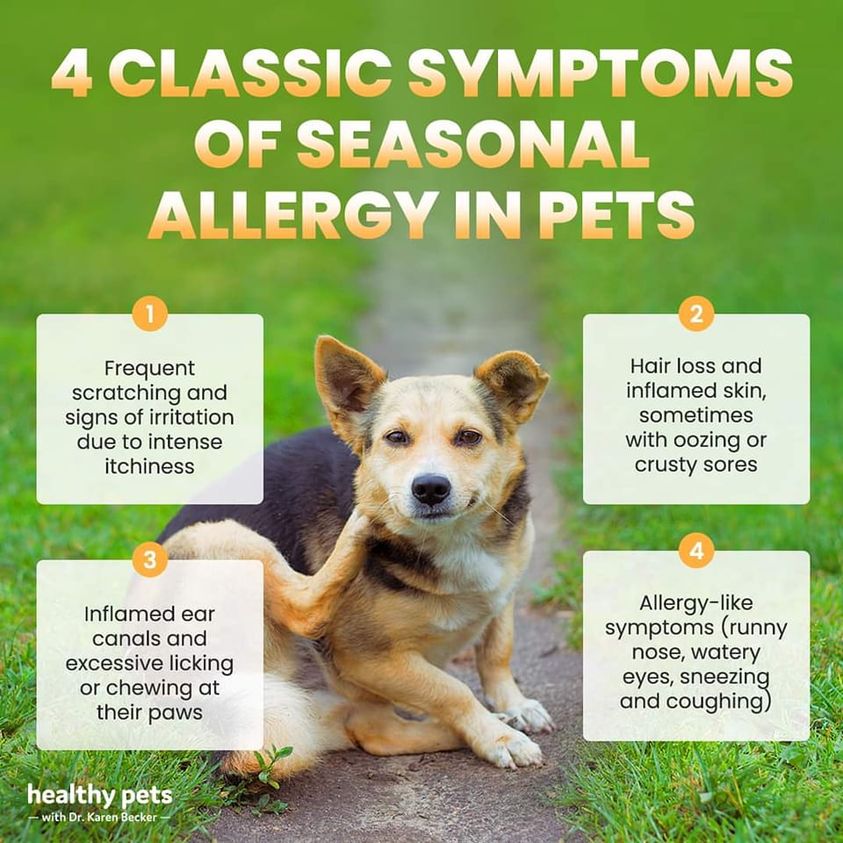
2. FOOD ALLERGIES
“Food allergy” is a term that is widely used by pet owners and vets, but in most cases, it could be more of an intolerance or sensitivity to certain foods or ingredients, but still something to be addressed. It might not necessarily be a reaction by the immune system, but rather one by the digestive system. Most vets will probably suggest an elimination diet trial to try and find out what causes the allergy. Remember that you don’t always need the most expensive food on the market to curb the allergy, especially if it is highly processed.
The authors of The Forever Dog, which includes Dr. Karen, writes that coconut meat or unsweetened dried coconut chips are the perfect single-ingredient treat for dogs suffering from food allergies. It has been shown to improve beneficial gut bacteria and strengthen the gut lining.
Interestingly they also write how studies show that the more puppies are offered healthy human table scraps, the more protection they have from developing allergies later in life.
3. DUST MITES AND FLEAS
Dust mites survive on a diet of dead skin, bacteria, fungi and viruses in the environment. They prefer to feed on the skin of hypersensitive (allergic) individuals because the lipids in their skin are different from those of non-allergic people and pets. What makes them allergenic is a protein found in their feces. One important step to help with this is to replace your dog’s bed with a safe, nontoxic pet bed made of organic materials like silk since dust mites can’t survive in silk.
It’s important to note that fleas aren’t typically attracted to healthy pets. They’re drawn to the weakest animals they can find, first, so one of the best defenses against flea infestations is to feed your dog a nutritionally balanced, species-appropriate fresh-food diet that will help keep his immune system functioning optimally. They still need tick and flea treatment and Dr. Karen suggests opting for non-toxic or chemical treatments on the market.
Read more about ticks & fleas and how to get rid of them naturally here.
Subscribe free to Dr. Karen’s tick & flea guide.
4. OTHER ENVIRONMENTAL ALLERGENS
There are so many other things in the environment and your home that can cause allergies to certain pets. Mold, pollen, trees, certain plants (some even toxic to pets), grass, even your stay soft, cleaning products, their toys and bedding, your deodorants/perfume or scented candles and the fumes of non-stick cookware might hold risks for pets too. Have you ever considered the health impact of what products you use on your lawn or in your garden? Anything applied to your lawn will end up in your pet. It is important, as their guardian (owner) to create a safe environment for them and to keep them healthy.
DR. KAREN SHARES WHAT YOU CAN DO.
- Diet – Evaluate their diet and supplement it with essential fatty acids (EFA) and lauric acid.
- Environmental factors – It’s important to remove the environmental factors that can negatively impact your dog’s immune system, including:
- Poor water quality – make sure to provide fluoride- and chlorine-free drinking water.
- Too many vaccines – you can ask your vet to run a titer test first instead of giving unnecessary vaccinations.
- Toxic household chemical load – eliminate dog beds treated with PBDEs (flame retardants) and toxic household cleaners.
- Yard chemicals – eliminate pesticides, herbicides and fertilizers around your home.
- EMFs – provide your dog with a safe zone that’s free from toxic levels of electromagnetic fields from electrical devices in the home.
3. Talk to a trusted vet – Talk to your integrative veterinarian about giving your pet natural antihistamines, and if necessary, consider a desensitization protocol ideally initiated before the start of allergy season.
4. Baths & foot soaks –
- Once warm weather arrives, rinse your pet regularly and do daily foot soaks and eye rinses. Since dogs and cats who are outside a lot collect millions of allergens, it’s just common sense to rinse them off, which can provide immediate relief for irritated, inflamed skin.
- When it’s time to actually bathe pets (when they’re stinky, dirty, or have a skin infection), Dr. Karen recommends using only grain-free and pH-balanced shampoos. Oatmeal is a carbohydrate and carbs can feed yeast, she doesn’t recommend oatmeal shampoos for yeasty pets.
- Follow up with a lemon juice or vinegar rinse to help manage yeast infections. Just add one cup of vinegar or one cup of lemon juice — or 10 drops of peppermint oil with 10 drops of lavender oil — to about 4 litres (a gallon) of water. Since lemon juice can also lighten fur, she usually recommends vinegar or the essential oil mixes for dogs with dark coats. Using cooled green tea as a soothing rinse can also help with inflamed and irritated skin. Do not try this if your pet is allergic to the ingredients.
See other health rinses here and images by Dr. Karen below.
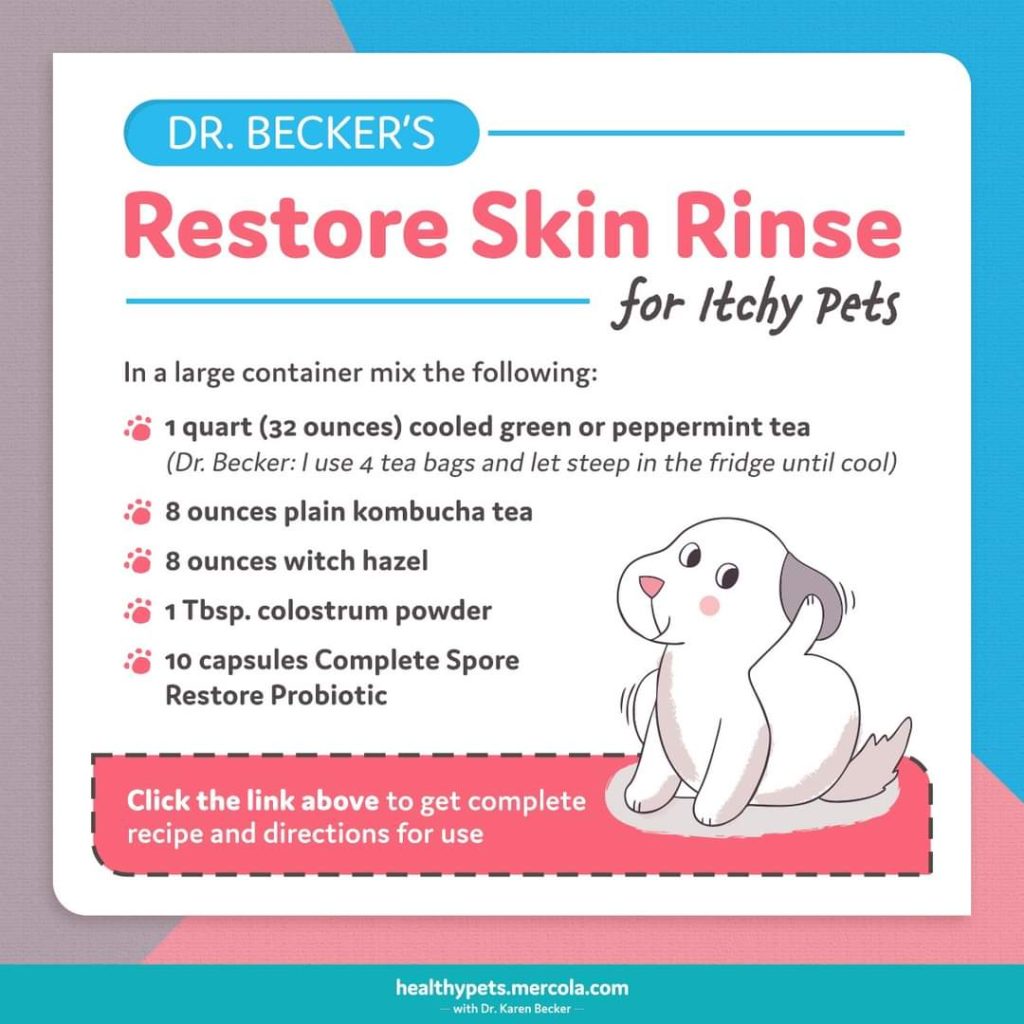
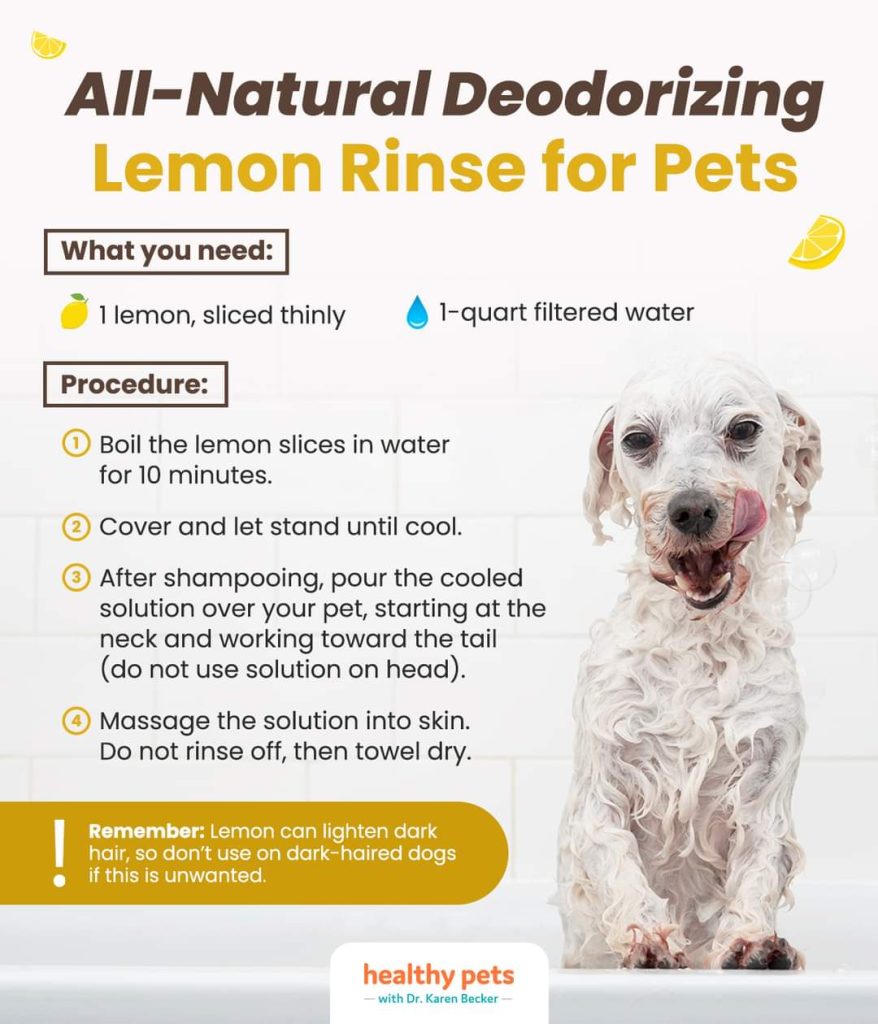
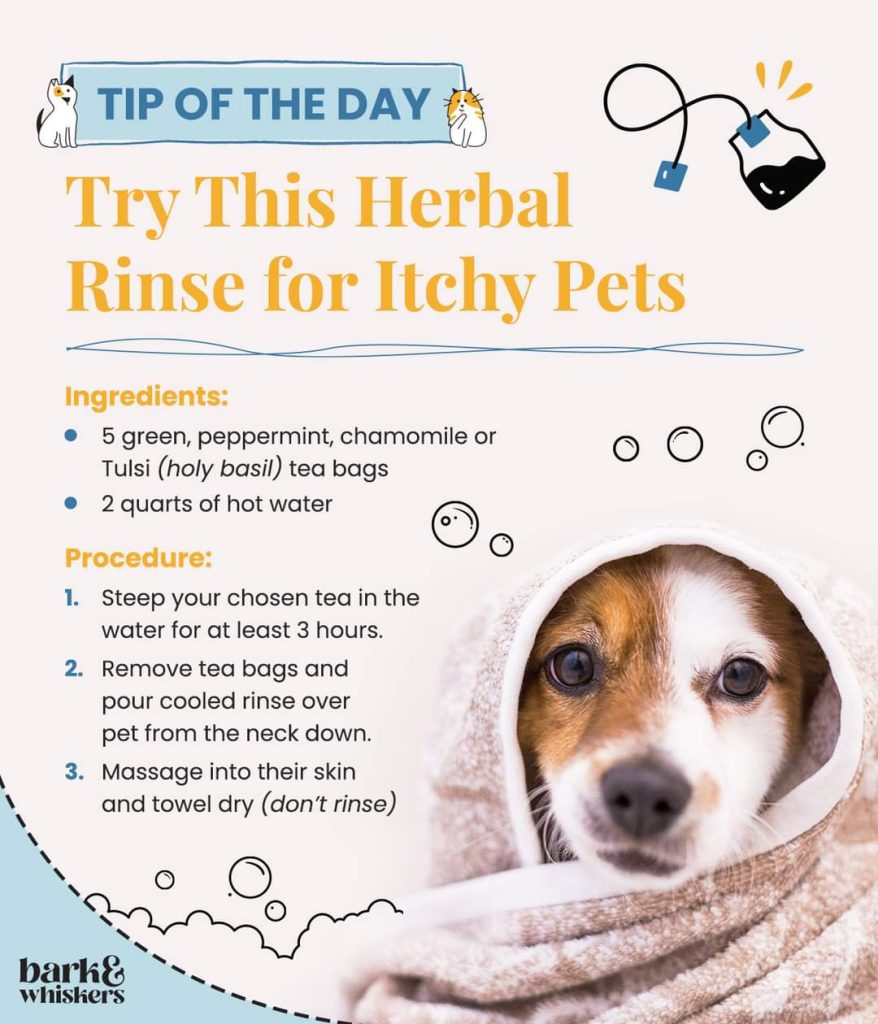
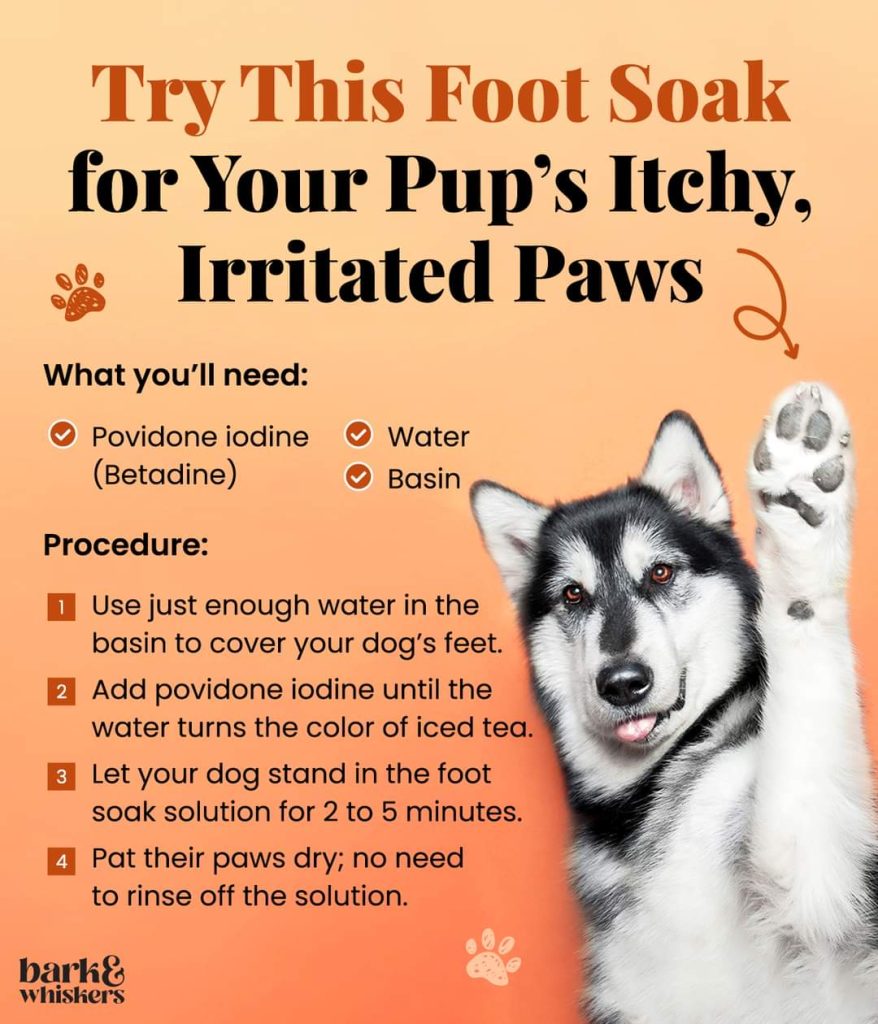
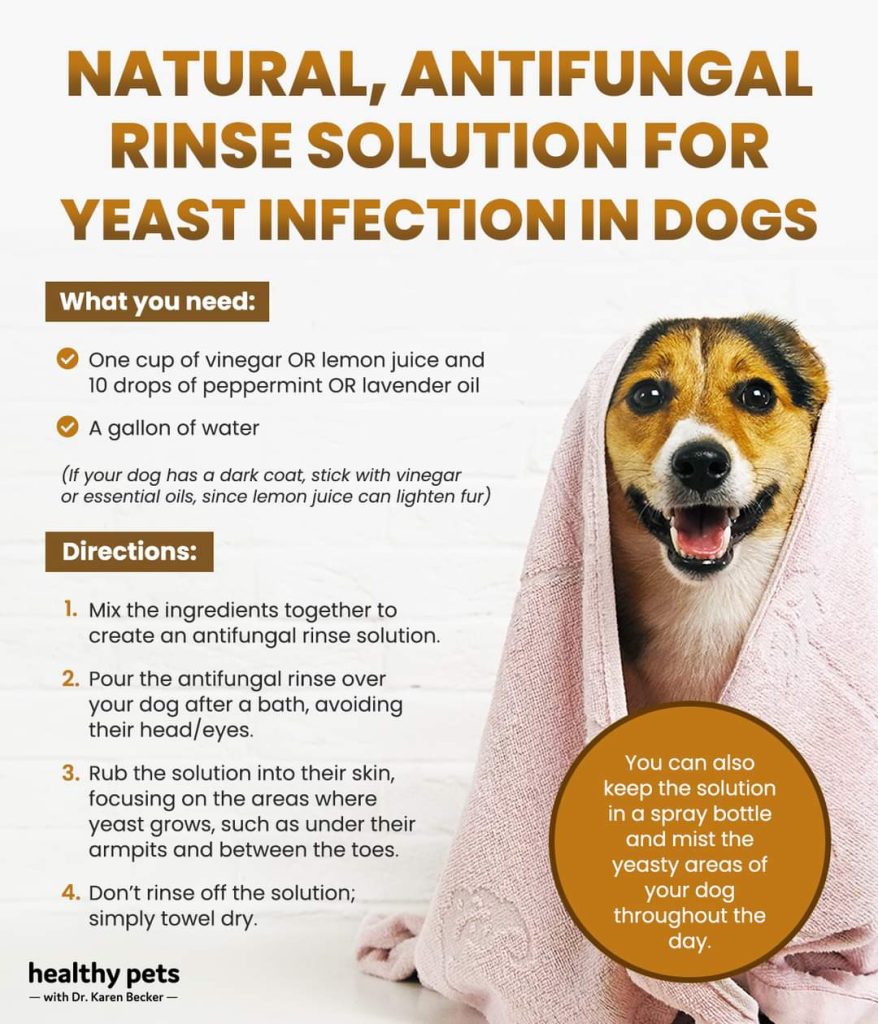
ITCHY PAWS ALL-NATURAL PAW SOAK
This simple home remedy can dramatically reduce your pet’s intense itch by removing the allergens causing them and helping them enjoy life more!
- For foot soaks use povidone-iodine (brand name, Betadine), which is an organic iodine solution found at local drug stores.
- Add just enough water in the foot soak to cover your dog’s feet, and enough iodine to turn the water to the colour of iced tea.
- Alternative – use white vinegar diluted 50/50 with water, especially if your dog’s coat or paws are light in colour, since Betadine may darken light fur.
- Can use once a day.
- There’s no need to rinse your dog’s feet after the soak. Just pat the paws dry and you’re done.
- To receive the full benefit of the soak, your dog needs to stand in the solution for 2 to 5 minutes.
- Keeping the paws submerged is key.
- Don’t go more than 2 or 3 days using the same foot soak solution.
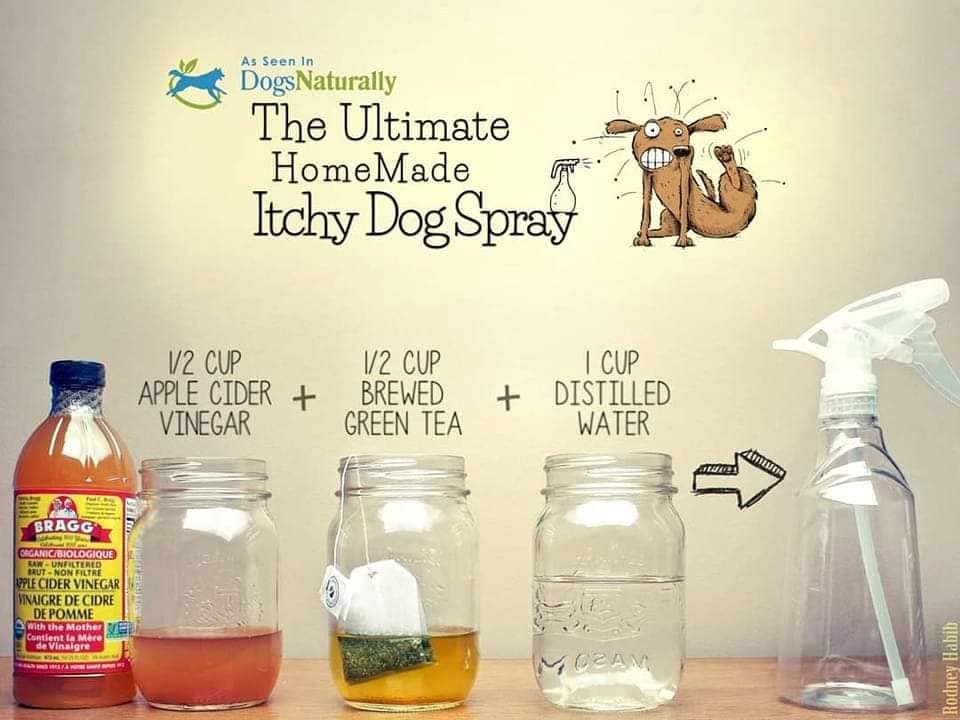
- Keep in fridge.
- Can spray on several times a day.
As with all this advice, please make sure your pet is not allergic to the products or ingredients and it shouldn’t cause unnecessary stress, so introduce it slowly and offer rewards for it.
Also read about feral cats
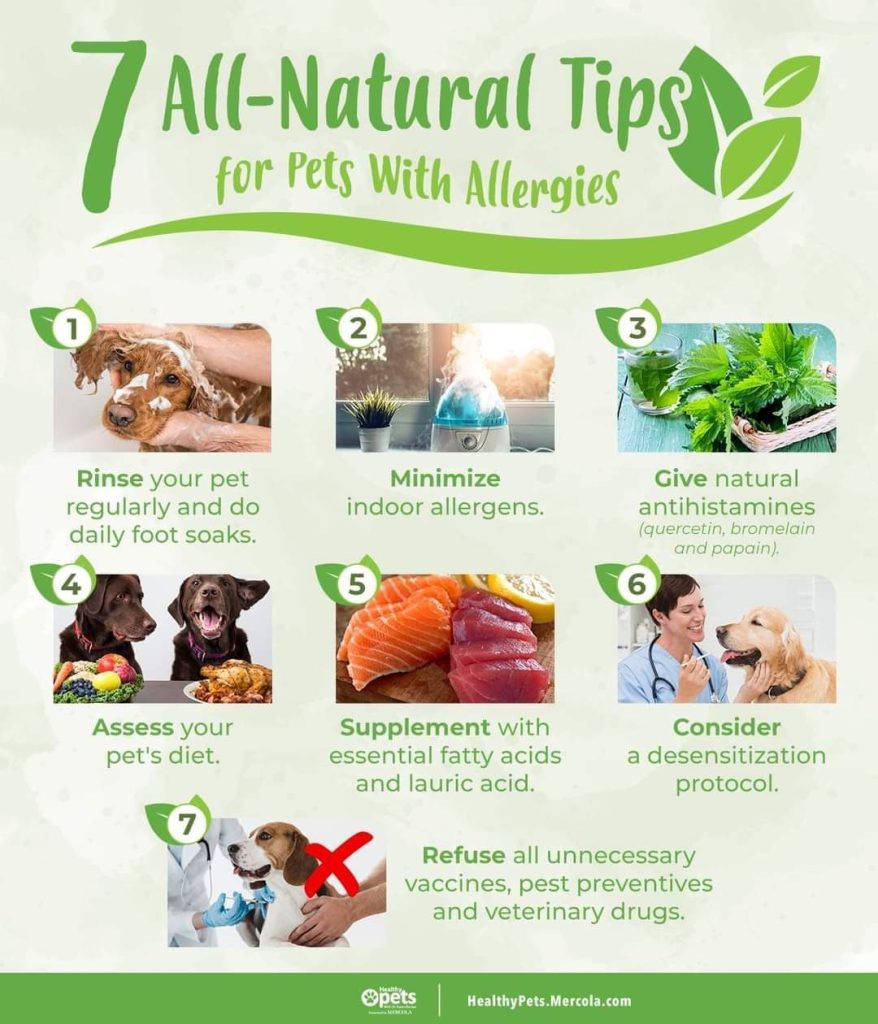
DO YOU THINK YOU ARE ALLERGIC TO YOUR PETS?
Another great article by Dr. Karen Becker shared how, contrary to popular belief, pet allergies are not caused by pet hair. Rather, they’re often caused by pet dander, saliva or a specific protein found only in intact male dogs. If you or a family member loves dogs but is allergic to them, you’ve probably at least considered that a “hypoallergenic” dog might make sense for you. According to the science, there’s no truly hypoallergenic dog, however, there are certain breeds that are considered better for allergy sufferers than others.
A 2011 study published in The American Journal of Rhinology and Allergy concluded that the amount of dog allergens found in households with dogs does not vary depending on the breed. In other words, families with so-called “hypoallergenic” dogs are living with the same level of allergens in their homes as people with non-hypoallergenic pets.
Interestingly it appears that some people are allergic only to male dogs. In an interview with CNN, allergist Dr. Lakiea Wright of Brigham and Women’s Hospital in Boston explains: “Up to 30% of people who are allergic to dogs are actually allergic to one specific protein that’s made in the prostate of a dog. If you’re allergic to only that specific protein in the male dog, you may be able to tolerate a female or a neutered dog.”
This is yet another good reason to get your pets spayed and neutered.
Keep your pets healthy and address the allergies as soon as possible to prevent any further discomfort or pain for your pets. Please choose to use cruelty-free products in your home too (cleaning & cosmetic).
Next week we will look at some basics about first aid for pets.
WHEN YOU KNOW BETTER, DO BETTER!